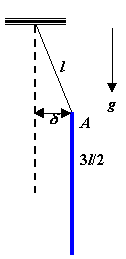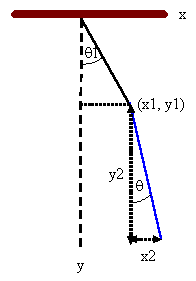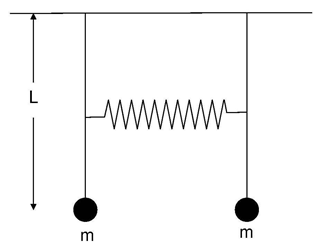Coupled oscillations, pendula
Problem:
A pendulum is composed of two masses, 3m and m, and two strings of equal
length L as shown.

At t = 0 the system is released from rest with the upper (heavier) mass not
displaced from its equilibrium position and the lower mass displaced to the
right a distance a.
x2(0) = 0, x1(0) = a << L.
Find an expression for the subsequent motion of the lower mass, x1(t).
Solution
- Concepts:
Small, coupled oscillations; normal modes
L = ½∑ij[Tij(dqi/dt)(dqj/dt) - kijqiqj]
with Tij = Tji, kij = kji.
Solutions of the form qj = Re(Ajeiωt) can
be found. We can find the ω2 from det(kij - ω2Tij)
= 0.
- Reasoning:
We are asked to find the motion of the masses for small displacements.
- Details of the calculations:
Let Φ1 and Φ2 be the generalized coordinates. Then
x2 = LsinΦ2, x1 = L(sinΦ1 + sinΦ2),
y2 = LcosΦ2, y1 = L(cosΦ1 + cosΦ2).
For small displacements we have sinΦ = Φ, cosΦ = 1 - Φ2/2.
The kinetic energy of the system is
T = (3/2)m[(dx2/dt)2 + (dy2/dt)2]
+ ½m[(dx1/dt)2 + (dy1/dt)2]
Let us only keep terms up to second order in Φ and dΦ/dt. Then
(dx2/dt)2 + (dy2/dt)2 = L2(dΦ2/dt)2,
(dx1/dt)2 + (dy1/dt)2 = L2[(dΦ2/dt)2
+ (dΦ1/dt)2 + 2(dΦ1/dt)(dΦ2/dt)].
T = (3/2)mL2(dΦ2/dt)2 + ½mL2[(dΦ2/dt)2
+(dΦ1/dt)2 + 2(dΦ1/dt)(dΦ2/dt)].
The potential energy of the system is
U = -mgy1 - 3mgy2 = (mgL/2)(Φ12
+ 4Φ22) + constant.
We have:
T = ½∑ij Tij(dΦi/dt)(dΦj/dt),
U = ½∑ij kijΦiΦj.
T11 = mL2, T22 = 4mL2, T12
= T21 = mL2,
k11 = mgL, k22 = 4mgL, kij(i ≠ j) = 0.
 .
.
ω2 = (g/L)(8 ± 4)/6, ωa2 = 2(g/L), ωb2
= (2/3)(g/L).
Φi = Aiexp(iωαt)
For mode a: A2 = -A1/2
For mode b: A2 = A1/2
Most general motion for a system starting from rest:
Φ1 = Aexp(iωat) + Bexp(iωbt), Φ2
= -(A/2)exp(iωat) + (B/2)exp(iωbt).
with A and B complex constants.
x1 = L(Φ1 + Φ2),
x2 = LΦ2.
x1 = L(|A|/2)cos(ωat + φa) + L(3|B|/2)cos(ωbt
+ φb),
x2
= -L(|A|/2)cos(ωat + φa) + L(|B|/2)cos(ωbt
+ φb).,
or
x1 = A'cos(ωat + φa) + 3B'cos(ωbt
+ φb),
x2
= -A'cos(ωat + φa) + B'cos(ωbt + φb),
with A' and B' real constants.
dx2/dt = -ωaA'sin(ωat + φa) - ωb3B'sin(ωbt
+ φb),
dx1/dt = ωaA'sin(ωat + φa) - ωbB'sin(ωbt
+ φb).
Initial conditions: x1(0) = A'cos(φa) + 3B'cos(φb) =
a, x2(0) = -A'cos(φa) + B'cos(φb) =
0.
--> A'cos(φa) = B'cos(φb) = a/4.
v1(0) = -ωaA'sin(φa) - ωb3B'sin(φb)
= 0, v2(0) = ωaA'sin(φa) - ωbB'sin(φb)
= 0.
--> sin(φa) = sin(φb) = 0, cos(φa) =
cos(φb) = 1, A' = B' = a/4.
Subsequent motion of the lower mass:
x1(t) = (a/4)cos ωat
+ (3a/4)cos ωbt.
Problem:
A uniform thin rod of length 3l/2 and mass m is supported at one end A by a
weightless string of length l under the gravitational force near the earth
surface.
(a) Calculate the normal modes and normal frequencies of small oscillations for
motion in a vertical plane.
(b) Now the end point A is slowly displaces by a small amount δ, (without
gaining any kinetic energy.) The system is then released from rest and allowed
to move freely. What is the subsequent motion?

Solution:
- Concepts:
Small oscillations:
L = ½∑ij[Tij(dqi/dt)(dqj/dt) - kijqiqj]
with Tij = Tji, kij = kji.
Solutions of the form qj = Re(Ajeiωt) can
be found.
For a particular frequency ωα we solve
∑j[kij - ωα2Tij]Ajα
= 0
to find the Ajα. The most generαl solution for eαch coordinαte qj
is α sum of simple hαrmonic oscillαtions in αll of the frequencies ωα.
qj = Re∑α(CαAjαexp(iωαt)).
- Reasoning:
We are asked to find the normal modes for small displacements.
- Details of the calculations:

(a) The position of the CM of the rod is X = x1 + x2/2,
Y = y1 + y2/2.
For the rod we have:
T = ½m[(dx1/dt + ½ dx2/dt)2 + (dy1/dt
+ ½ dy2/dt)2] + ½I(dθ/dt)2.
T is the kinetic energy of the motion of the CM and the motion about the CM.
U = -mg(y1 + y2/2) + constant.
For small oscillations x1 = lsinθ1 ~lθ1, x2
= (3/2)lsinθ ~ (3/2)lθ.
y1 = lcosθ1 ~ l(1 - θ12/2), y2
= (3/2)lcosθ ~ (3/2)l(1 - θ2/2).
To second order in the small quantities we have:
T = ½ml2((dθ1/dt)2+¾2(dθ/dt)2+(3/2)(dθ1/dt)(dθ/dt)+½(3/16)ml2(dθ/dt)2)
= ½ml2((dθ1/dt)2+¾(dθ/dt)2+(3/2)(dθ1/dt)(dθ/dt))
= ½∑Tijqiqj.
q1 = θ1, q2 = θ, T11 = ml2,
T22 = ¾ml2, T12 = T21 =
¾ml2.
U = mgl[(q12/2) +¾l(q22/2)] = ½∑kijqiqj.
k11 = mgl, k22 = ¾mgl, k12 = k21
= 0.
 .
.
We have a solution if
 .
.
¾(g-ω2l)2 -(9/16)ω4l2 = 0,
ω4 - 8(g/l)ω2 + 4g2/l = 0.
ω2 = [4 ± (12)½]g/l.
mode 1: ω12 = [4 + (12)½]g/l.
(g - [4 + (12)½]g)A1 - ¾[4 + (12)½]gA2
= 0. A1 = -0.866 A2.
mode 2: ω22 = [4 - (12)½]g/l.
(g - [4 - (12)½]g)A1 - ¾[4 - (12)½]gA2
= 0. A1 = 0.866 A2.
(b) The most general solution is
qj = Re∑α(CαAjαexp(iωαt)).
θ1 = Re(c1exp(iω1t) + c2exp(iω2t)),
θ = (1/0.866)Re(-c1exp(iω1t) + c2exp(iω2t)).
Initial conditions:
θ1(0) = δ/l, θ(0) = 0, dθ1/dt = dθ/dt = 0 at t = 0.
Re(c1 + c2) = δ/l, Re(c1 - c2)
= 0, Re(c1) = Re(c2) = δ/(2l).
Re(iω1c1 + iωc2) = 0, Re(-iω1c1
+ iωc2) = 0.
Im(ω1c1 + ωc2) = 0, Im(ω1c1
- ωc2) = 0, Im(c1) = Im(c2) = 0.
θ1(t) = (δ/(2l))[cosω1t + cosω2t], θ(t) =
(δ/(2*0.866*l))[cosω1t - cosω2t].
Problem:
Two pendula, each of which consists of a weightless rigid rod length of L and
a mass m, are connected at their midpoints by a spring with spring constant k.
Consider only small displacements from equilibrium.

(a) What are the frequencies of the normal modes of this system? Briefly
describe these modes.
(b) At t = 0 the right pendulum is displaced by an
angle θ to the right while the left pendulum remains vertical. Both pendula are
released from rest. Describe the subsequent motion.
Solution:
-
Concept:
Coupled small oscillations
-
Reasoning:
We are asked to solve for the motion of two coupled pendula.
-
Details of the calculation:
(a) Call the left pendulum 1
and the right pendulum 2. Let θi denote a small angular displacement
of pendulum i to the right.
Small angle approximation: sinθ = θ, cosθ =
1 in the equations of motion.
Define x1 = Lθ½,
x2 = Lθ2/2
τ1 = Iα1 = mL2d2θ1/dt2
= -mgLθ1 - kL2(θ1 - θ2)/4
τ2
= Iα2 = mL2d2θ2/dt2 = -mgLθ2
- kL2(θ2 - θ2)/4
Equations of motion:
d2θ1/dt2
= -(g/L)θ1 - (k/m)(θ1 - θ2)/4
d2θ2/dt2
= -(g/L)θ2 - (k/m)(θ2 - θ1)/4
Try solutions
of the form θi = θi0 exp(iωt). Then

Solve for ω by setting the determinant of the matrix equal to zero.
ω2 = (g/L + k/(4m)) ± k/(4m).
ω12 = g/L, θ10 = θ20,
the pendula oscillate in phase.
ω22 = g/L + k/(2m),
θ10 = -θ20, the pendula oscillate 180o out of
phase.
(b) Most general solution:
θ1(t)
= Re(C1exp(iω1t) + C2exp(iω2t))
θ2(t) = Re(C1exp(iω1t) - C2expi(ω2t))
dθ1(t)/dt = Re(iω1C1exp(iω1t) +
iω2C2exp(iω2t))
dθ2(t)/dt =
Re(iω1C1exp(iω1t) - iω2C2expi(ω2t))
Initial conditions at t = 0:
Re(C1 + C2) = 0,
Re(C1 - C2) = θ20, Re(C1)
= - Re(C2) = θ20/2.
Im(ω1C1+
ω2C2) = 0, Im(ω1C1+ ω2C2),
Im(C1) = Im(C2) = 0.
θ1(t) = (θ20/2)(cos(ω1t)
- cos(ω2t))
θ2(t) = (θ20/2)(cos(ω1t)
+ cos(ω2t))


 .
.

 .
. .
.
